C.A.A. Savastano's Blog, page 10
May 27, 2019
The DGI Revealed

Join historian Mike Swanson and author C.A.A. Savastano to discuss the operations, membership, and origins of the Cuban DGI intelligence group. Documents and discussion reveal the undertakings of this assumed minor group revealed in declassified documents to be more prominent that some expect.
May 15, 2019
The DGI

Offered for your review is a recent addition of the Primary Evidence Collections that features new research, evidence, and extensive information about the Cuban General Directorate of Intelligence. It presents the historical structure, leadership, relevant documents, and useful resources to support additional public research.
April 29, 2019
Killing the Wrong Revolutionary
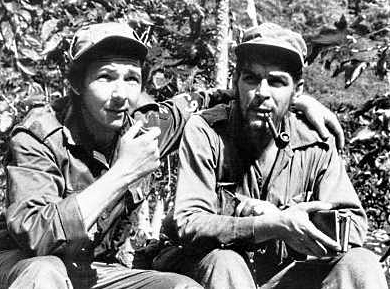
Raul Modesto Castro Ruz and Ernesto “Che” Guevara during 1957
During the Cold War the United States government spent tens perhaps hundreds of millions of dollars seeking the death of their greatest perceived Communist nemesis in the Western hemisphere, Fidel Castro. He was everything business interests and corporations feared, a formerly rich person who embraced violent populism, nationalization of industry, and overturning the established order of Cuban society for communal doctrine. Years passed and the foretold implosion of the Castro regime failed to materialize due in part to widespread popularity and the brutal repression of dissident voices. This left a stark enemy camped just less than one hundred miles from the United States and Castro began to dominate the imagination of several anti-Communist leaders. Yet what if Fidel Castro was not the true Communist influence but instead just the dominant ego of the regime, what if all those failed plots were not just a costly series of failures but failed targeting the right Castro.
The chance for amicable relations between Cuba and the United States following the Cuban Revolution in nineteen fifty-nine seemed more likely in the early winter of that year. According to one document, President Eisenhower had appointed a replacement Cuban Ambassador to smooth over relations and prevent the prior officeholder's support for the defunct Batista regime from affecting diplomacy. When the Eisenhower administration's new ambassador met his diplomatic counterpart, the American president hoped for an "ever closer relationship between Cuba and the United States."i International relations seemed poised to make significant progress in the wake of Cuba's revolution if these two governments located common ground.
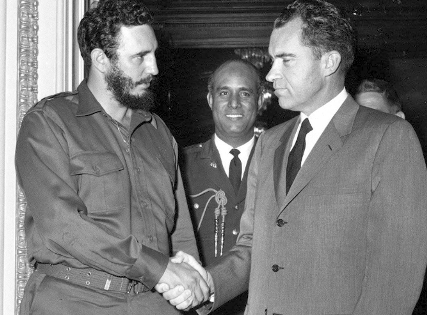
Richard Nixon and Fidel Castro “NEGOTIATED” in 1959
Regrettably, a meeting between Fidel Castro and American Vice-President Richard Nixon seemed to initiate a dramatic slide in diplomatic relations. "Castro left the meeting convinced that Nixon was hostile towards Cuba. Nixon's impression of Castro's Communist beliefs led him to recommend President Eisenhower take measures to quash the Cuban revolution. According to the recollections of Ambassador Bonsal, Nixon perceived the situation to be so serious that he advocated an active role by the CIA in providing arms, ammunition, and training of Cuban exiles for use against the Cuban government."ii These suggestions would form government policy in the following decade as more unlikely and exotic methods to dispose of Castro proved beyond the ability of related leaders.
On repeated occasions in the early days of his power, Fidel Castro stated that Cuba was "neither Communist or Capitalist, while his brother Raul Castro clearly and specifically identifies the Cuban revolt with the previous Communist government of Guatemala". The Central Intelligence Agency prior in nineteen fifty-four overthrew the fallen Communist allied government of Jacobo Arbenz held in esteem by Raul Castro on the orders of Eisenhower administration. Raul also told public media that he admired Communist leaders such as China's Mao Tse-tung and that capitalists were the common enemy of Cuba and other Communist aligned nations. Yet not everyone in the CIA believed Nixon's claim that Fidel Castro represented the primary communist threat.
Leo Cherne was an economist, lawyer, advised nine United States presidents, and was a Central Intelligence Agency adviser. During nineteen fifty-nine, Cherne reported in one of his many political journals that Fidel Castro was not the organizing force of the Communist rise in his government. Castro's relationship with the Eisenhower administration had soured but he was not yet avowedly communist. Conversely, his brother Raul Castro was steeped deeply in the Marxism that later defined Cuba's new government. Cherne advised that Raul's place in Cuba's developing society were "misunderstood and underestimated". "Although Raul's influence within the Revolution is not new, his public emergence as the real organizer of the government is significant." While Fidel Castro operated as the supreme leader of the regime, he left the details of establishing and implementing desired laws to his brother.
Fidel tasked Raul with selecting key appointments in the government that included the Cuban president, armed forces leadership, and government control of land reforms. These land reforms would include the nationalization of foreign businesses that seized all the holdings multiple powerful corporations. While undertaking a consistent political doctrine under Communist tenets, Raul additionally used his political influences to remove or intimidate political moderates into compliance with his ideology. The younger Castro brother was effectively manipulating a growing discord with the United States that Nixon had so foolishly began. Cherne notes, "Whether Fidel Castro fully realizes it or not, he had by now all but lost the ability to balance off Raul's power by backing moderates or middle class figures." The CIA adviser clarifies the Castro brothers have differed in policy before such as when Raul launched a military invasion of Panama and his forces kidnapped United States citizens without consulting Fidel. The Cuban Premier did not support Raul's brazen move and he ordered the immediate withdrawal of all forces. By curtailing this and other dangerous gambits the more pragmatic Fidel understood a powerful enemy nation might crush the infant revolutionary government if sufficiently incited.
Failures of policy and the compelling desire to strike at this potential threat overwhelmed most contending analysis. While Fidel was publicly opposed to training outside expeditionary revolution forces abroad, Raul supported the development of such forces in Haiti, Nicaragua, and the Dominican Republic. The older brother previously insisted on just the exportation of revolutionary ideas, Raul instead was committed to the "export of revolutionary muscle." Fidel at one event joked, "If anything should happen to me...you will have my more violent brother to contend with."iii It may be the Congressional testimony of a former leading Cuban military officer to the United States government took the rightful Communist suspicion from Raul and transferred it to a more visible figure.
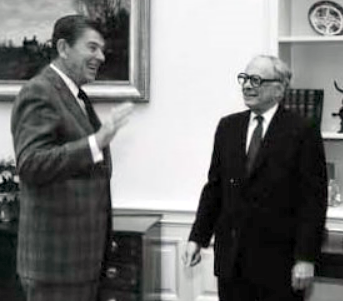
Leo Cherne visits US President REAGAN during the 1980s
The analysis of Leo Cherne after visiting Cuba multiple times in nineteen fifty-nine states that former Cuban Air Force Chief Pedro Diaz Lanz labeled Fidel Castro a Communist distorted the matter. Diaz Lanz following his defection was prevented from giving information to intelligence organizations for confirmation until after his testimony to garner maximum effect in the press. This public intervention by America "at the hands of Senator Eastland, who is an open admirer of Dictator Trujillo" was a serious mistake diplomatically. "Nothing could better suit the Latin American Communists or more impede the work of U.S. Embassies or the State Dep't." Unfortunately, the subsequent American government policy targeting Fidel Castro using assassination was more akin to the interventionist activities favored by Raul. This undoubtedly led Fidel to embrace his brother's call to purge capitalism from Cuba and consider all nations supporting it as their lethal political enemy.
The American State Department did not appreciate Cherne's unvarnished appraisal of developments in Cuba that did not conform to popular government sentiments. When CIA representatives consulted the State Department on Cherne's upcoming report they replied thinking "it was a good idea for Cherne to make an honest, factual report; however, that they would like to have him, in his report, stick as close to Department policy as possible." Official haste to protect departmental policy would force Cherne to minimize some of the useful information and the primary mover toward Communism in Cuba would remain hidden.iv This disastrous miscalculation would feasibly realign the perceived status of which Castro brother was the primary Communist threat.
A CBS news program debating the slide of island nation into a Communist dictatorship featured Cuban delegate to the United Nations Carlos Lechuga who declared, "Cuba is rapidly becoming one of the most solid democracies of the hemisphere."v The Castro representative states despite "the mass executions" that followed Castro's ascension in the early days of his rule it was not true that opposition voices were suppressed. Additionally, popular "reforms" of the Cuban government included the violent or financial disruption of opposition press along ideological lines.vi Each unlawful act verified the worst claims about Castro while distancing any chance of finding common ground. While Cuba under Castro was indeed not yet a declared communist state, the island was never a functional democracy following the introduction of state approved domestic purges.
Attempts by the United States to interfere in Cuban interests against some popular reforms, retaliatory actions of the Cuban government, and the poor diplomacy between national leaders set further political gears into motion. As the arrest, torture, and execution of Cuban dissidents continued Raul Castro visited Moscow on a diplomatic mission and Ernesto "Che" Guevara declared in the press "the Revolution was on the road set by Marx" and seemingly this path in Cuba became nearly inevitable.vii The same year the Eisenhower administration increased economic trade pressures on Cuba and authorized Nixon's suggested arming and training of Cuban rebels to overthrow Castro. The Central Intelligence Agency employed Mafia leaders to consider assassinating Fidel Castro and things quickly spiraled into a series of repeated failed undertakings that became a legendary example of official skulduggery.
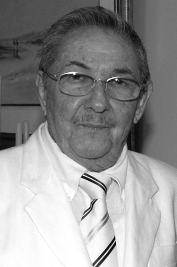
Cuban President Raul Modesto Castro in 2009
American leaders chose embracing clandestine operations in spite of useful opposing intelligence analysis to the great detriment of policy. Why did they ignore repeated signs indicating not Fidel but Raul Castro was the seeming Communist threat guiding Cuba to a political conflict with opposition governments? Administrators wasted a colossal amount of resources, agents, and years in futile assassination efforts and the Bay of Pigs nearly sparked a war. If they had been successful in their limitless desire and Raul Castro had assumed power in the shadow of his politically martyred brother, how many people in both nations would have died in the resulting violence for killing the wrong Castro?
Sincerely,
C.A.A. Savastano
References:
i. House Select Committee on Assassinations, Segregated Central Intelligence Agency file, No Title, p. 1, National Archives and Records Administration Identification Number: 180-10142-10396
ii. Ibid, p. 3
iii. HSCA, Seg. CIA file, Reel 4, Folder B, Cherne-Conte, Cherne, Leo, Urgent report on Cuba, August 1, 1959 pp. 1-2, 1994.03.09.09:22:49:750005
iv. Ibid, Telephone Conversation with Leo Cherne, July 27, 1959, pp. 1-2
v. Ibid, "Is Cuba Going Red? Pat II", May 28, 1959, p. 4
vi. HSCA, Seg. CIA file, No Title, p. 2
vii. Ibid. p. 4
Related Articles
Cuban Relations
Exiled Cuban Crusaders
The Autonomous Groups
Related Podcasts
Operation Mongoose
AMLASH 1, 2, 3
April 14, 2019
C.A.A. Savastano returns to The Past American Century
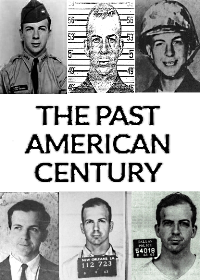
Lee Harvey Oswald and his actions have dominated much of the public discussion about the JFK case, but has this constant focus on him taken away the greater view of events in the JFK assassination? C.A.A. Savastano and your host Mike Swanson discuss this and other related historical subjects.
March 24, 2019
The Past American Century Podcast w/ C.A.A. Savastano

The Past American Century podcast is back! Historian Mike Swanson and researcher Carmine Savastano discuss the Warren Commission and its famous Single Bullet Theory. The official idea is compared to some contending evidence, diverging official expert testimony, and the assumptions required to believe it definitely proves its claims.
March 14, 2019
Blurred Minds

Some theorize a hypnotized assailant carried out the attack of multiple famous public figures and even believe such acts might occur while a separate mental suggestion could wipe the killer's memory leaving them a hapless pawn. It is wholly reasonable to support a person can be manipulated, lied to, and indoctrinated given enough time and isolation. If these actions were coupled with repeated negative psychological treatment, torture, or the use of drugs, a person's will can be drastically reduced or their memory can be permanently clouded. However, there is no scientifically proven way to render someone a programmed killer without any self-determination or memory despite the repeated public assertions it might occur. The erroneous modern concept of limitless mental control began decades ago with the assistance of government propaganda and resulting public speculations.
Many claims of mind control attribute rapid occurrences and not the extensive process some governments utilized relying on extensive mental or physical abuse. The related term brainwashing was "coined by a journalist named Edward Hunter, who had served in the Morale Operations section of the U.S. Office of Strategic Services during the Second World War." He spent most of "his time in Asia and became an outspoken anti-Communist" offering the concept of brainwashing to explain why Communism would appeal to a person rather than address less diabolical motivations. Hunter wrote the text "Brainwashing in Red China: The Calculated Destruction of Men's Minds" in nineteen fifty-one and states "brainwashing" is his translation of a Chinese term meaning a "cleansing of the mind". He asserts hearing the term during conversations with "Europeans who had been caught inside China in 1949, the year of Mao's revolution."
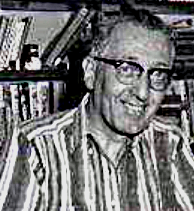
OSS & CIA MEMBER Edward Hunter
This idea had multiple variant definitions, "For Hunter-who turned out to be an agent of the CIA's propaganda wing-it was a mystical, Oriental practice that couldn't be understood or anticipated in the West...But for scientists who actually studied American POW's once they returned from Korea, brainwashing was altogether less mysterious...The men had been tortured."i However, the indoctrination methods condemned by Hunter confirm months and years in captivity might render someone willing to commit violence but days or weeks could only procure a speech or feigned submission to likely stop torture. The quick conversions required extensive mental or physical abuse in recorded cases and was not permanent but eventually ceased when the victim was outside a captor's influence. Claims that direct physical abuse can be quickly replaced with psychological methods for shorter periods are not supported by most verified data. "Had Chinese and Soviet Communist really uncovered a machine or method to rewrite men's minds and supplant their free will? The short answer is no-but that didn't stop the U.S. from pouring resources into combating it."ii
This spurred the Central Intelligence Agency to launch its attempt at mind control codenamed MKULTRA using "hallucinogens (like LSD) and biological manipulation...to see if brainwashing were possible. The research could then, theoretically, be used in both defensive and offensive programs against the Soviet Union. Project MKULTRA began in 1953 and continued in various forms for more than 10 years...The files revealed the experiments tested drugs (like LSD), sensory deprivation, hypnotism and electroshock on everyone from agency operatives to prostitutes, recovering drug addicts and prisoners-often without their consent." This intrinsic forced approach never produced actual brainwashing using aforementioned methods, what they did create were traumatized people.iii The more traumatized a person the more violent behavior is possible but increasing unpredictability reduces the benefit of using them for intelligence operations. The Agency of course attempted to destroy all records of these failed attempts to develop mind control due to the potential and later actual damage exposure rendered.iv
The United States Army issued a report in nineteen fifty-five regarding the indoctrination of prisoners of war, four thousand soldiers were interviewed and many had "underwent intensive indoctrination by Chinese Communists. The Chinese had carefully segregated the prisoners they identified as incorrigibles, sometimes housing them in separate camps, and had subjected the prisoners judged to be potential converts to five hours of indoctrination a day, in classes that combined propaganda by the instructors with 'confessions' by the prisoners. In some cases, physical torture accompanies the indoctrination, but in general the Chinese used the traditional methods of psychological coercion: repetition and humiliation over extended periods." Yet this subversion of a prisoner's will did not render a willing assassin and the more quickly suggestions diverged from a subject's normal behavior the more difficult further indoctrination became.
Though Communist's did mentally influence captured American troops during the Korean War, less exotic means than later imagined were employed. One captured American soldier who "delivered a radio speech consisting of North Korean propaganda" two days following his capture disturbed Western officials and such fears compounded after several imprisoned soldiers repeated the event on multiple occasions. By the conflict's end, estimates of troop collaboration numbered one in ten, twenty-one soldiers chose not to return to the United States, forty men had converted to Communism, "and fourteen were court-martialed" resulting in eleven convictions. The United States Army discovered that a shocking number of prisoners had, to one degree or another, succumbed."
Chinese agents used these methods to break the will of prisoners and it resulted in broken detainees signing false statements that were accepted by many internationally to be accurate. Extended mental torture could over larger periods of months and years traumatize someone into substantial complicity but not seemingly in the short term. The widely held public belief in brainwashing or mental control does not distinguish any reasonable limitations inferred by scientific evidence and study. The military's report would inspire a public obsession with the topic and media sources spread prisoner stories as the word brainwashing "became a synonym for any sort of effective persuasion". Some writers compared it to advertising and psychological treatments while a public mixing of verifiable political indoctrination, texts on Pavlovian classic conditioning, and comparisons to hypnotism combined in certain instances. Reported brainwashing alarmist Frederic Wertham even published a book named "The Seduction of the Innocent" denouncing the asserted subtle control that comic books wielded over American youth. All of these varying levels of fact and myth began to swirl into a muddy concept some would claim is reliable but lacks sufficient demonstrable examples of mind control. Despite the verifiable facts, the specter of mind control ironically hypnotizes several people limited only by their worst imaginings.
Scientific experts and inquiry reveals the vast majority of such mental conditioning has a limited duration and psychiatrist Robert Jay Lifton following his interview of returning prisoners of war "concluded that the indoctrination of prisoners was a long-term failure. All of the 'converts' eventually returned to the United States, and the former prisoners who had come home praising the good life to be had in North Korea soon reverted to American views." Seemingly, there were no permanent brainwashing methods beyond regular indoctrination augmented with additional environmental stress. The entire proven method does not result in total control but influencing a person to act as desired.
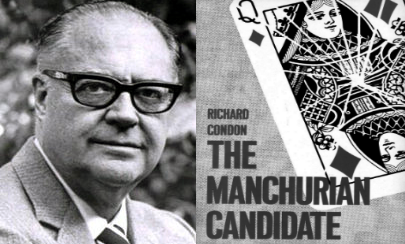
Richard COndon and his Best-Selling Book “The Manchurian Candidate”
During nineteen fifty-nine, movie publicist Richard Condon wrote a piece of best-selling fiction titled "The Manchurian Candidate" that spurred a film of the same title to achieve minor cult status.v Condon's experience as a promotions man could partially explain the idea's endurance coupled with Cold War politics, pulp fiction, and prior more realistic circumstances. Richard Condon seemingly capitalized on the growing fear and paranoia regarding Communism during the Cold War by making vast assumptions regarding the powers of the Red Menace. Condon's addition to the already large mixture of factual and fictional details further clouded the issue publicly. The terms mind control; brainwashing, indoctrination, and hypnotic suggestion have now melded into a seemingly amorphous mass of ideas.
The central problem with claims of hypnotic or mental domination is they rely on depriving a person of complete will and assert being able to utterly wipe subsequent memories. Among the vital portions of successful hypnotism attempts is the participation of the subject, they must be willing to accept the proposed ideas and the subject must also develop an extended rapport with the person attempting hypnotism. Notably, there is not a single verifiable related instance of rendering a human being without the ability to resist unless physical force or extended suppressive methods are employed. Unlike the entertainment-based claims of stage hypnotism one might observe at state fairs or school assembly, the snap of someone's fingers and soothing words alone do not render effective hypnosis. Stage hypnosis can produce reactions on stage when employing a very suggestible volunteer or in less honest cases a planted actor. Consider that stage hypnotism occurs in front of audiences with the expectation of a performance, a participant's desire for becoming part of the spectacle, and in several instances does not initiate even minor hypnotic effects. One popular "stage hypnosis" show affirms, "Hypnotized people are NOT mindless automations subject to the bidding of the hypnotist. It's extremely difficult to get a hypnotized person to do anything against their moral principles."vi
One related psychological study offers, "Brainwashing theories serve the interests of those espousing them in a number of ways." Such ideas lacking most verifiable evidence can generate interest in the longstanding fascination people have with the human mind and its manipulation but are founded upon less than credible science. "The hard determinism approach assumes that human can be turned into robots through the application of sophisticated brainwashing techniques."vii The modern tendency of many to embrace determinism in brainwashing or mental conditioning via psychological techniques does not comport with reality. Some people are not easily susceptible to influencing methods such as indoctrination and most related experts recognize humans beings are "more complex entities" than some psychological brainwashing advocates might appreciate. Yet facts would not subsequently prevent one hypnotist from claiming that Lee Harvey Oswald, the alleged assassin of President Kennedy, might have been hypnotized by the Soviets.viii The effectiveness of past official propaganda to influence public ideas regarding exaggerated hypnotic powers becomes increasingly clear.
Later attempts to deprogram assertedly "brainwashed" people using methods that include hypnotism exposed not hypnotic methods but the will of the subject to change their behavior is the prevailing factor. At least one prior study of such attempts concluded the subject of cult deprogramming must desire to change their behavior just as they originally had for indoctrination based on mental or social influences. There is a proven voluntary element required to allow external influences to direct our actions, no person can be utterly deprived of all control to perform a series of complex tasks with hypnotism. Even the subject's expectation that hypnotism can be successful or future sessions will be helpful can influence the results demonstrating the voluntary nature possible success is based on.ix One professor studying related phenomenon notes that concepts of brainwashing similar to hypotheses on radicalization may obscure more than reveal factual circumstances. "Both terms could be a lazy way of refusing to inquire further into individual histories, inviting the assumption that the way people act can be known in advance."
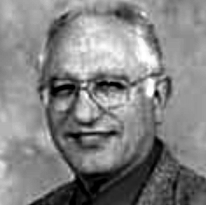
President of the American SOCIETY CLINICAL Hypnosis Dr. Moshe Torem
A preposterous idea is that hypnotism can render someone temporarily into a violent person and then erase all memory of this transition and resulting acts. Professional hypnotism can increase chances of augmenting some behavior such as quitting smoking or enhancing pain relief via concentration techniques and relaxation but fifty-six academic studies on hypnosis confirm it does not assure changed or programmed behavior. Basic problems with hypnosis include lacking a set definition, techniques can vary based on practitioners or education, and no "common or standard intervention technique" can be assessed. One United States Health and Human Services study offers that independent review of nine different hypnotherapy studies "found insufficient evidence to support hypnosis as a treatment for smoking cessation." Hypnosis is not a reliable universal method to explain aberrant behaviors defying our expectations but can be used to assist invoking desired results similar to meditation. There is not enough verifiable data to prove it has any significant effect and if actions the subject desires to occur repeatedly fail, how more unlikely is the chance forced hypnotism might occur. Professor of Psychiatry at Northeastern Ohio Medical University and President of the American Society of Clinical Hypnosis Moshe Torem states, "Hypnosis is just a tool that helps in making what you're trying to do easier."x
The assassination of Senator Robert F. Kennedy presents scientific evidence and witness testimony that Sirhan Bishara Sirhan did not fire the shots killing Robert Kennedy, but he did fire several bullets into a small area full of people. He is not innocent of all guilt but he did not have the means to possess the alleged murder weapon until he was assisted. Nevertheless, some asserting hypnotism venture beyond the facts desiring to grant Sirhan utter innocence and claim he remembered nothing about the act because he was a mentally programmed assassin. They appear to consider him a later-day Manchurian candidate, as per the movie, yet there is no substantial evidence to support the idea despite the volume of those promoting it.
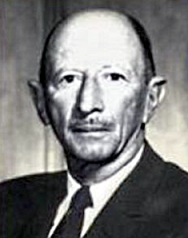
Emile Zola Berman one of SIRHAN SIRHAN’s Multiple Attorneys
Sirhan's conscious decisions to self hypnotize effectively made him more susceptible to influence by outside forces and prone to irrational beliefs. It proves untenable to suggest that an emotionally traumatized, mentally injured, and unwilling subject committed involuntary violence in a short time contrary to his own morality. Even one of Sirhan's advocates Emile Zola Berman reveals hypnotism does not prevent a person from lying or having false memories based on associated scientific analysis that sets additional factual limits upon the assumed power of hypnotism.xi Despite this, advocates of hypnotic control deny Sirhan's willing participation in the attack but among the key elements for effective hypnosis is "relaxation" and this would largely preclude violent instructions unless the subject viewed them favorably.xii Additionally, due to a prior serious head injury Sirhan was an unpredictable subject at best, no deep scientific study of his injuries and to extent they affected his memory or behavior occurred at the time. While a temporary memory loss due is common following some forms of hypnosis, this not the extensive selective memory rewriting offered by proponents of mental control.
Evidence details the occurrence of at least one alleged criminal conspiracy officials suppressed between Sirhan and his brother Munir. Further witness statements affirm the realistic possibility of others being involved in guiding these events as well and repeated official actions to suppress and destroy evidence while discrediting contending accounts. However, none of those facts and legal statements requires mind control and similar unproven hypnotism assumptions to declare a conspiracy. Without substantial evidence that can survive psychological inspection and demonstrate these vast improbable claims in a legal setting, there is no justified reason to embrace them.
Sincerely,
C.A.A. Savastano
References:
i. Lorraine Boissoneault, (May 22, 2017), The True Story of Brainwashing and How It Shaped America, Smithsonian Magazine, smithsonian.com
ii. Louis Menand, (September 15, 2003), Brainwashed : Where the Manchurian Candidate came from, New Yorker Magazine, newyorker.com
iii. Assassination Record Review Board, Files of Analyst Manuel Legaspi, MKULTRAT.WPD, June 22, 2017
iv. United States Senate Select Committee to Study Governmental Operations with respect to Intelligence Activities, Miscellaneous Records, No Title, April 24, 1975, National Archives and Records Administration Identification Number: 157-10014-10218, pp. 5-7
v. L. Menand, Brainwashed
vi. Eric Kand, (n.d.), Myths about Hypnosis-Is Hypnotism Real?, Erik Kand Stage Hypnotist, hypnosisevents.com
vii. James T. Richardson, (December 10, 1999), A Social Psychological Critique of "Brainwashing" Claims about recruitment to new religions, Center for Studies on New Religions, censur.org
viii. President's Commission Document 121, FBI Wilson Report re: Oswald, Theory advanced that Russian trained Lee Harvey Oswald for Assassination of President Kennedy through Post Hypnotic Suggestion, December 6, 1963
ix. Mark P. Jensen, Tomonori Adachi, Catarina Tome-Pires, Jikwan Lee, Zubaidah Jamil Osman, and Jordi Miro, ( Janaury 1, 2016), Mechanisms of Hypnosis, United States Health and Human Services Department, National Institute of Health, ncbi.nlm.nih.gov, pp. 34-75
x. Luke O' Neil, (May 6, 2105), Can You Quit Smoking Through Hypnosis?, The Atlantic, theatlantic.com
xi. Supreme Court of California, People v. Sirhan Bishara Sirhan, Testimony of Emile Zola Berman, March 21, 1969, p. 6924
xii. Susan Krauss Whitbourne, (July 7, 2012), The How-Tos of Hypnosis, Psychology Today, psychologytoday.com
Related Podcasts
Micro Macro Mind Control
March 8, 2019
The Facts and Myths of Mind Control
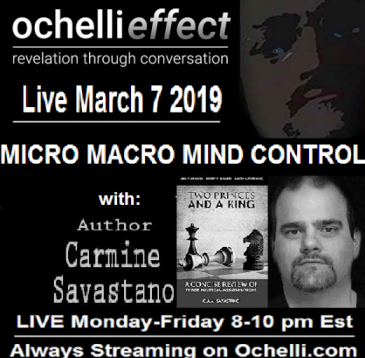
Is mind control possible? The Ochelli Effect features a discussion of claims and evidence regarding the possibilities and limitations of mental influencing. These claims regarding such techniques and their possible use in multiple historical assassinations is reviewed.
February 18, 2019
The Past American Century: Willoughby and Walker

Join your host Mike Swanson and his guest C.A.A. Savastano as they discuss allegations related to US Generals Charles Willoughby and Edwin Walker. Their discussion reviews evolving stories and seek to distinguish what connections to President Kennedy’s assassination rely on substantial evidence and some improbable official assumptions.
February 3, 2019
JFK 101 Part 16: The Present JFK Case
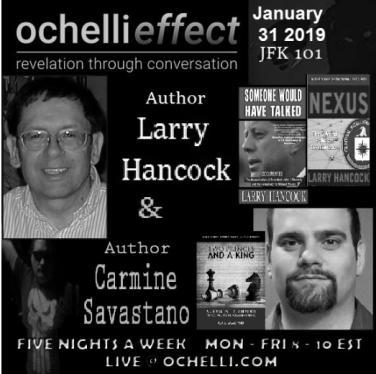
The first season of a nearly two-year sixteen-episode journey assessing the assassination of President John F. Kennedy ends in this episode of the Ochelli Effect's JFK 101 series. Author Larry Hancock, researcher C.A.A. Savastano, and your host Chuck Ochelli return to offer developments in the case and ideas about the next season of JFK 101.
January 23, 2019
C.A.A. Savastano returns to the Past American Century
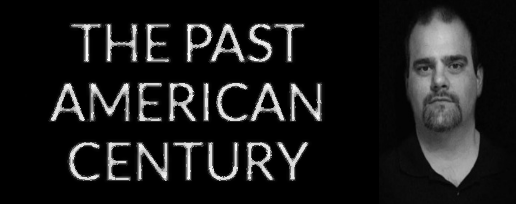
Join historian Mike Swanson and author Carmine Savastano to discuss new research and evidence that establishes significant problems with the claims associated with Richard Case Nagell and the assassination of President John F. Kennedy.



